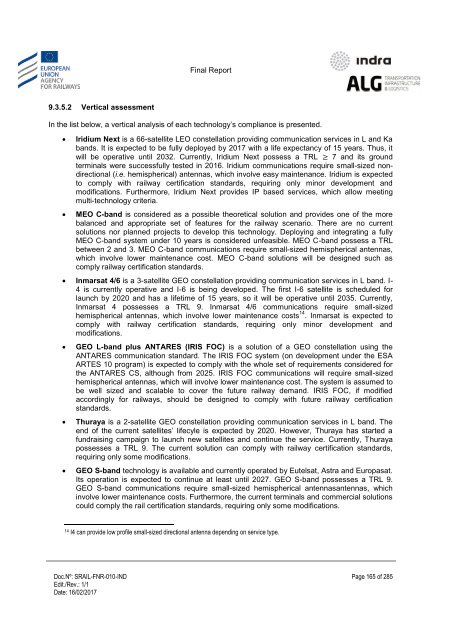Study on feasibility of SATCOM for railway communication
SRAIL-FNR-010-IND%20-%20FinalReport_v1.1_20170216
SRAIL-FNR-010-IND%20-%20FinalReport_v1.1_20170216
Create successful ePaper yourself
Turn your PDF publications into a flip-book with our unique Google optimized e-Paper software.
Final Report<br />
9.3.5.2 Vertical assessment<br />
In the list below, a vertical analysis <strong>of</strong> each technology‘s compliance is presented.<br />
<br />
<br />
Iridium Next is a 66-satellite LEO c<strong>on</strong>stellati<strong>on</strong> providing communicati<strong>on</strong> services in L and Ka<br />
bands. It is expected to be fully deployed by 2017 with a life expectancy <strong>of</strong> 15 years. Thus, it<br />
will be operative until 2032. Currently, Iridium Next possess a TRL 7 and its ground<br />
terminals were successfully tested in 2016. Iridium communicati<strong>on</strong>s require small-sized n<strong>on</strong>directi<strong>on</strong>al<br />
(i.e. hemispherical) antennas, which involve easy maintenance. Iridium is expected<br />
to comply with <strong>railway</strong> certificati<strong>on</strong> standards, requiring <strong>on</strong>ly minor development and<br />
modificati<strong>on</strong>s. Furthermore, Iridium Next provides IP based services, which allow meeting<br />
multi-technology criteria.<br />
MEO C-band is c<strong>on</strong>sidered as a possible theoretical soluti<strong>on</strong> and provides <strong>on</strong>e <strong>of</strong> the more<br />
balanced and appropriate set <strong>of</strong> features <strong>for</strong> the <strong>railway</strong> scenario. There are no current<br />
soluti<strong>on</strong>s nor planned projects to develop this technology. Deploying and integrating a fully<br />
MEO C-band system under 10 years is c<strong>on</strong>sidered unfeasible. MEO C-band possess a TRL<br />
between 2 and 3. MEO C-band communicati<strong>on</strong>s require small-sized hemispherical antennas,<br />
which involve lower maintenance cost. MEO C-band soluti<strong>on</strong>s will be designed such as<br />
comply <strong>railway</strong> certificati<strong>on</strong> standards.<br />
Inmarsat 4/6 is a 3-satellite GEO c<strong>on</strong>stellati<strong>on</strong> providing communicati<strong>on</strong> services in L band. I-<br />
4 is currently operative and I-6 is being developed. The first I-6 satellite is scheduled <strong>for</strong><br />
launch by 2020 and has a lifetime <strong>of</strong> 15 years, so it will be operative until 2035. Currently,<br />
Inmarsat 4 possesses a TRL 9. Inmarsat 4/6 communicati<strong>on</strong>s require small-sized<br />
hemispherical antennas, which involve lower maintenance costs 14 . Inmarsat is expected to<br />
comply with <strong>railway</strong> certificati<strong>on</strong> standards, requiring <strong>on</strong>ly minor development and<br />
modificati<strong>on</strong>s.<br />
<br />
<br />
<br />
GEO L-band plus ANTARES (IRIS FOC) is a soluti<strong>on</strong> <strong>of</strong> a GEO c<strong>on</strong>stellati<strong>on</strong> using the<br />
ANTARES communicati<strong>on</strong> standard. The IRIS FOC system (<strong>on</strong> development under the ESA<br />
ARTES 10 program) is expected to comply with the whole set <strong>of</strong> requirements c<strong>on</strong>sidered <strong>for</strong><br />
the ANTARES CS, although from 2025. IRIS FOC communicati<strong>on</strong>s will require small-sized<br />
hemispherical antennas, which will involve lower maintenance cost. The system is assumed to<br />
be well sized and scalable to cover the future <strong>railway</strong> demand. IRIS FOC, if modified<br />
accordingly <strong>for</strong> <strong>railway</strong>s, should be designed to comply with future <strong>railway</strong> certificati<strong>on</strong><br />
standards.<br />
Thuraya is a 2-satellite GEO c<strong>on</strong>stellati<strong>on</strong> providing communicati<strong>on</strong> services in L band. The<br />
end <strong>of</strong> the current satellites‘ lifecyle is expected by 2020. However, Thuraya has started a<br />
fundraising campaign to launch new satellites and c<strong>on</strong>tinue the service. Currently, Thuraya<br />
possesses a TRL 9. The current soluti<strong>on</strong> can comply with <strong>railway</strong> certificati<strong>on</strong> standards,<br />
requiring <strong>on</strong>ly some modificati<strong>on</strong>s.<br />
GEO S-band technology is available and currently operated by Eutelsat, Astra and Europasat.<br />
Its operati<strong>on</strong> is expected to c<strong>on</strong>tinue at least until 2027. GEO S-band possesses a TRL 9.<br />
GEO S-band communicati<strong>on</strong>s require small-sized hemispherical antennasantennas, which<br />
involve lower maintenance costs. Furthermore, the current terminals and commercial soluti<strong>on</strong>s<br />
could comply the rail certificati<strong>on</strong> standards, requiring <strong>on</strong>ly some modificati<strong>on</strong>s.<br />
14<br />
I4 can provide low pr<strong>of</strong>ile small-sized directi<strong>on</strong>al antenna depending <strong>on</strong> service type.<br />
Doc.Nº: SRAIL-FNR-010-IND<br />
Edit./Rev.: 1/1<br />
Date: 16/02/2017<br />
Page 165 <strong>of</strong> 285


